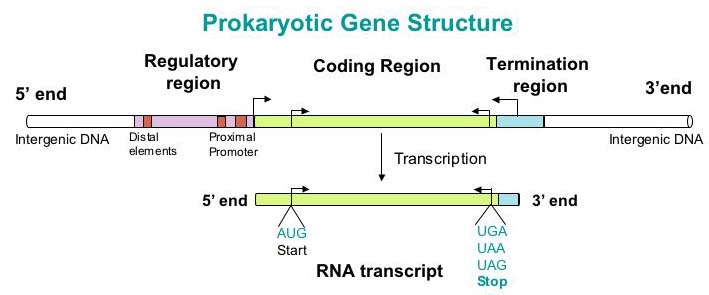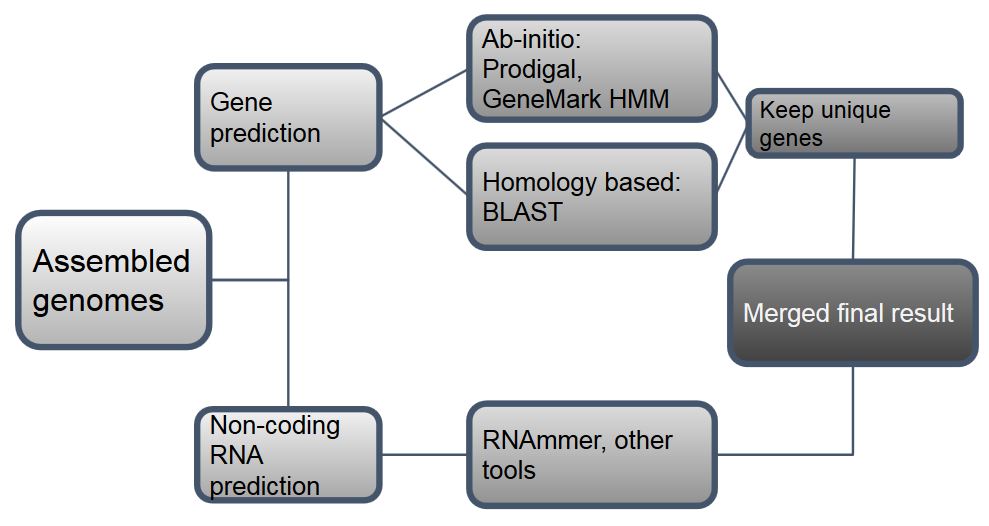Team I Gene Prediction Group: Difference between revisions
Added Prodigal section and skeleton for some other sections |
|||
| Line 70: | Line 70: | ||
Command: | Command: | ||
<pre>Genemark</pre> | <pre>Genemark</pre> | ||
'''GLLIMMER''' | |||
Command: bash run_glimmer.sh [assembly] | |||
Run_glimmer.sh includes: | |||
1) Create output directories GFF/ | |||
2) GLIMMER calling, done through a pipeline script GLIMMER3 provides g3-from-scratch.csh | |||
3) Parsing and conversion of GLIMMER outputs to GFF | |||
Parameters used: (default in g3-from-scratch.csh) | |||
-o 50: max prediction overlap length | |||
-g 110: min gene length | |||
-t 30: max entropy distance score | |||
-d 7 : depth of interpolated context model | |||
-p 3: period of interpolated context model | |||
-w 12: width of interpolated context model | |||
Input: assembly FASTA file | |||
Output: Gene table (.predict and .detail) and byproducts (.icm, .train, .longorfs) | |||
Reference: https://ccb.jhu.edu/software/glimmer/glim302notes.pdf | |||
=== ncRNA Methods === | === ncRNA Methods === | ||
Revision as of 19:51, 26 March 2018
Introduction
Data
We were given assemblies of 258 isolates of Klebsiella spp..
Background
Our overarching goal is to understand what causes heteroresistance in Klebsiella spp. At this step, our objective was, given assembled genomes, to predict genes for Klebsiella that could later be annotated to understand functionality.
Gene Prediction
Gene prediction is the process of identifying the specific regions of genomic DNA that encode for genes. After sequencing and assembly, gene prediction is one of the first steps in understanding the genome of a species. In the past, confirming that the gene prediction is accurate demanded in vivo experimentation through gene knockout and other assays. Today, bioinformatics research has made it possible to predict the function of a gene based on its sequence alone. There are two general methods to do this: homology-based tools and ab-initio tools.
There is a big difference between prokaryotic and eukaryotic gene prediction. For eukaryotes, genes may be separated by introns, which makes it challenging to find the whole genomic sequence. Promoter sequences are more complex and less well understood in eukaryotes as well. In prokaryotes, the promoter regions are well understood, which is useful when using ab initio tools, since these tools search for signs of specific signs of protein coding genes. In prokaryotic genomes there are also contiguous open reading frames (ORFs) - when paired with the high amount of stop codons in prokaryotes this can indicate, with high probability, a gene being present. Our challenge when looking at ORFs is that every gene is a ORF, but not every ORF is a gene.
Methods
Pipeline (general workflow)
Homology-Based Methods
Ab-inito Methods
Prodigal
Pros:
Cons:
Parameters used:
Input: assembly file (.fna) Output: gene coordinates (.gff), nucleotide sequences (.fna), protein sequences (.fna) Command:
prodigal -i input.fna -o output.gff -f gff -d nucleotide_seq.fna -a protein_seq.fna
Genemark
Pros:
Parameters used:
Input: assembly file (.fna) Output: Command:
Genemark
GLLIMMER
Command: bash run_glimmer.sh [assembly]
Run_glimmer.sh includes: 1) Create output directories GFF/ 2) GLIMMER calling, done through a pipeline script GLIMMER3 provides g3-from-scratch.csh 3) Parsing and conversion of GLIMMER outputs to GFF
Parameters used: (default in g3-from-scratch.csh) -o 50: max prediction overlap length -g 110: min gene length -t 30: max entropy distance score -d 7 : depth of interpolated context model -p 3: period of interpolated context model -w 12: width of interpolated context model
Input: assembly FASTA file Output: Gene table (.predict and .detail) and byproducts (.icm, .train, .longorfs)
Reference: https://ccb.jhu.edu/software/glimmer/glim302notes.pdf
ncRNA Methods
Infernal
Pros:
Parameters used:
Input: assembly file (.fna) Output: Command:
infernal
Results
References
https://ghr.nlm.nih.gov/primer/basics/gene
https://www.biostat.wisc.edu/bmi776/spring-15/lectures/IMMs.pdf
http://ece.drexel.edu/gailr/ECE-S690-503/markov_models.ppt.pdf
http://onlinelibrary.wiley.com/doi/10.1042/BC20070137/full#footer-citing
https://iweb.langara.bc.ca/biology/mario/Biol2315notes/biol2315chap11.h

